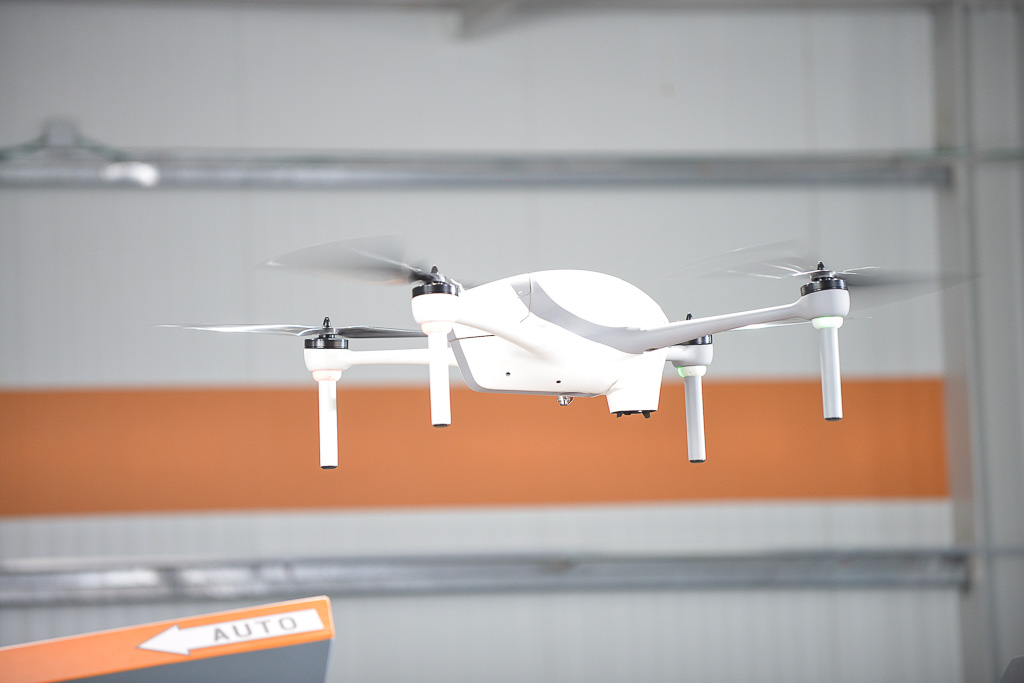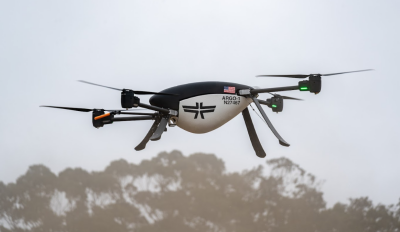Something you see and understand after taking a look across the industry is how developed commercial drone solutions have become. Taking a drone into the air isn’t a simple task, but advances in automation have made it an easier process. One company has made it a priority to push these developments in order to change the way operators approach their work as well as the way entire countries deal with regulation.
Airobotics has developed a platform that is fully automated which also provides the accuracy and reliability that users have come to expect from a commercial UAV solution. What’s more, their products have additional safety features built right into the platform. The Israeli company is currently in discussions with a few large potential customers in the United States, and is set to test and operate their products under Part 107.
Eitan Rotberg
 What do you mean?The ability to cover a certain amount of space is a key consideration for businesses. It's a major issue in agriculture because the value for the ground can be difficult to extract. A cornfield is not producing a lot of value if you compare it to the same area in a port or mine. So you need to cover much more area to get that same value. 2 square kilometers in agriculture is a much different value proposition than 2 square kilometers in mining. We’re looking to operate in high-value industries. Is that autonomous capability what makes your solution different?Yes, our automation capabilities are certainly unique.The thing that makes Airobotics different is that it's the only solution that automates the whole operation. Its automation extends from pre-flight checks all the way to automatic download and transmission of the data that's being gathered. It also extends across the entire operation, from when the drone is on the ground to when it's in the air and back on the ground.For most of the products on the market, you'll see an aspect or area that is missing. It can take off automatically, but it can't land. It can send data automatically, but then someone needs to manually process that info. Because aviation is so complicated and there's no room for mistakes, it's really hard to build a full solution that takes everything into account, but that’s part of the reason we’ve had success in heavy industry environments like mining and power plants.Our drone also has an integrated parachute. There are plenty of products that have something like this as an add-on, but here the parachute is a part of the product and combines with the drone. Aviation is all about managing risk, and it creates another level of protection for operators, participants and non-participants. What makes your solution specifically relevant to professionals in those markets?First, there’s the security aspect, and those naturally lead into safety issues. All of that comes together to HSE. That stands for health, security and environment. We’re able to provide live, automated feedback and video from the field to a central HQ and give people the ability to quickly see what's happening and then respond to it. People in these industries are working in dangerous environments with hazardous materials, and they need to be able to rely on a product that’s going to quickly get them info they need to handle any kind of situation.We take missions that are normally performed manually, by human teams, and provide a new way for the team to deliver results by automating these missions with drones. A good example is inspection of infrastructure and machinery, which is a common, time-consuming and many times a dangerous task.Our drone is also incredibly relevant to these professionals because of the impact it has on how a team approaches mapping. The collected measurements determine how things get done. On a mining project, where products are coming out of the ground and being moved, they need to be measured and mapped, A true automated drone system requires much less manual work and manpower, making the organization more lean and efficient. It's a major aspect. How have your clients responded to the fully autonomous nature of your product?Many of our clients don't see the drone fly and aren’t too concerned about the details. They only care about the data. It’s one of the reasons we're very focused on that piece.It’s the regulators who have had to get used to this kind of autonomy. Usually in aviation there's someone who is in charge of the operation. It's similar to what's happening with cars. If you're in an autonomous car and it crashes, who's responsible? Is it the company that made the car or the person behind the wheel?It's not something many clients think about, but we think all of the challenges associated with getting a UAV to fly without a pilot are solvable, as we've found some open atmospheres in Israel. I think it's going to be the same in other countries, because in the end everyone understands drones will operate autonomously.
What do you mean?The ability to cover a certain amount of space is a key consideration for businesses. It's a major issue in agriculture because the value for the ground can be difficult to extract. A cornfield is not producing a lot of value if you compare it to the same area in a port or mine. So you need to cover much more area to get that same value. 2 square kilometers in agriculture is a much different value proposition than 2 square kilometers in mining. We’re looking to operate in high-value industries. Is that autonomous capability what makes your solution different?Yes, our automation capabilities are certainly unique.The thing that makes Airobotics different is that it's the only solution that automates the whole operation. Its automation extends from pre-flight checks all the way to automatic download and transmission of the data that's being gathered. It also extends across the entire operation, from when the drone is on the ground to when it's in the air and back on the ground.For most of the products on the market, you'll see an aspect or area that is missing. It can take off automatically, but it can't land. It can send data automatically, but then someone needs to manually process that info. Because aviation is so complicated and there's no room for mistakes, it's really hard to build a full solution that takes everything into account, but that’s part of the reason we’ve had success in heavy industry environments like mining and power plants.Our drone also has an integrated parachute. There are plenty of products that have something like this as an add-on, but here the parachute is a part of the product and combines with the drone. Aviation is all about managing risk, and it creates another level of protection for operators, participants and non-participants. What makes your solution specifically relevant to professionals in those markets?First, there’s the security aspect, and those naturally lead into safety issues. All of that comes together to HSE. That stands for health, security and environment. We’re able to provide live, automated feedback and video from the field to a central HQ and give people the ability to quickly see what's happening and then respond to it. People in these industries are working in dangerous environments with hazardous materials, and they need to be able to rely on a product that’s going to quickly get them info they need to handle any kind of situation.We take missions that are normally performed manually, by human teams, and provide a new way for the team to deliver results by automating these missions with drones. A good example is inspection of infrastructure and machinery, which is a common, time-consuming and many times a dangerous task.Our drone is also incredibly relevant to these professionals because of the impact it has on how a team approaches mapping. The collected measurements determine how things get done. On a mining project, where products are coming out of the ground and being moved, they need to be measured and mapped, A true automated drone system requires much less manual work and manpower, making the organization more lean and efficient. It's a major aspect. How have your clients responded to the fully autonomous nature of your product?Many of our clients don't see the drone fly and aren’t too concerned about the details. They only care about the data. It’s one of the reasons we're very focused on that piece.It’s the regulators who have had to get used to this kind of autonomy. Usually in aviation there's someone who is in charge of the operation. It's similar to what's happening with cars. If you're in an autonomous car and it crashes, who's responsible? Is it the company that made the car or the person behind the wheel?It's not something many clients think about, but we think all of the challenges associated with getting a UAV to fly without a pilot are solvable, as we've found some open atmospheres in Israel. I think it's going to be the same in other countries, because in the end everyone understands drones will operate autonomously.  The way in which AI will impact the future of drone technology is something we’ve touched on, but that regulatory piece is always a critical consideration. Do you think countries can or should be working together to sort through regulatory concerns?Aviation regulation is built from the ground up, and while it can be a collaborative effort, all that really matters is being able to keep the airspace safe.When an airplane travels from Israel to Germany it passes over numerous countries. As it passed over those countries, they don't need to change the procedures or the licenses. It's built for international activity. Aviation authorities know how to transfer information from one place to the next. They are very developed in terms of learning from neighbors on aviation. Every country will have their own adjustments, but if something is working in Israel it will work in other countries too because aviation logics are similar everywhere. How should the differences in regulation impact the approach for anyone who wants to do business in another country?Much of that comes back to the decisions we made when we started Airobotics. We had to decide which country we were going to go to first. We could have gone to a place where no regulation existed at all and do what we want. We didn’t want to do that though, because we felt that countries with strong regulation and strong aviation authority are the best for us, because we believe that regulation has a lot of wisdom in it.There's a lot in regulation which forces companies to do things in the right way. That’s good for us, good for operators, good for the market, and good for the people in all of these places.In the end, a drone is an airplane and there's no room for mistakes, and crashes can lead to losses of money and even a loss of life. This is why we're continuing to focus on places that have strong regulation, and anyone who wants to do business in a place that takes a similar approach is going to set themselves up for success, regardless of the regulatory variations from one country to another.
The way in which AI will impact the future of drone technology is something we’ve touched on, but that regulatory piece is always a critical consideration. Do you think countries can or should be working together to sort through regulatory concerns?Aviation regulation is built from the ground up, and while it can be a collaborative effort, all that really matters is being able to keep the airspace safe.When an airplane travels from Israel to Germany it passes over numerous countries. As it passed over those countries, they don't need to change the procedures or the licenses. It's built for international activity. Aviation authorities know how to transfer information from one place to the next. They are very developed in terms of learning from neighbors on aviation. Every country will have their own adjustments, but if something is working in Israel it will work in other countries too because aviation logics are similar everywhere. How should the differences in regulation impact the approach for anyone who wants to do business in another country?Much of that comes back to the decisions we made when we started Airobotics. We had to decide which country we were going to go to first. We could have gone to a place where no regulation existed at all and do what we want. We didn’t want to do that though, because we felt that countries with strong regulation and strong aviation authority are the best for us, because we believe that regulation has a lot of wisdom in it.There's a lot in regulation which forces companies to do things in the right way. That’s good for us, good for operators, good for the market, and good for the people in all of these places.In the end, a drone is an airplane and there's no room for mistakes, and crashes can lead to losses of money and even a loss of life. This is why we're continuing to focus on places that have strong regulation, and anyone who wants to do business in a place that takes a similar approach is going to set themselves up for success, regardless of the regulatory variations from one country to another. 















Comments